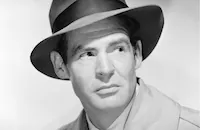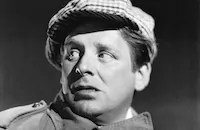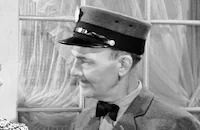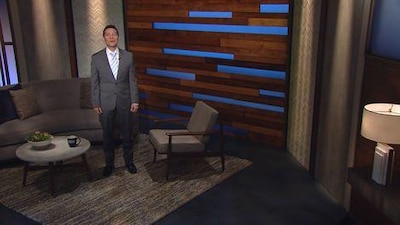The Set-Up

Brief Synopsis
Cast & Crew
Robert Wise
Robert Ryan
Audrey Totter
George Tobias
Alan Baxter
Wallace Ford
Film Details
Technical Specs

Synopsis
Outside a rundown boxing arena, where an evening of fights is about to begin, boxing manager Tiny and trainer Red discuss their aging heavyweight, Bill "Stoker" Thompson, who is schudeled to compete that night. A few minutes later, at the Ringside Café, Tiny accepts a fifty dollar bribe from gambler Little Boy, who wants Stoker to throw his four-round match and assure the up-and-coming Tiger Nelson a victory. Tiny agrees to Little Boy's stipulations that Stoker "go down" after the second round, then informs trainer Red that he is not going to tell Stoker about the deal, as he is sure the boxer will lose the bout anyway. In a nearby hotel, meanwhile, Stoker tries to convince his concerned wife Julie that even though he is thirty-five, he is still only "one punch away" from a "top spot." Julie, who has dutifully supported her husband's declining career, is unmoved by his boasts and begs him to retire from the ring. When Stoker insists on continuing, Julie sadly informs him that she will not watch him fight that night. Disturbed by Julie's words, Stoker grows pensive while being prepped in the arena's crowded dressing room and listens thoughtfully to the hopeful, nervous chatter of his fellow boxers. Before Shanley, a young and frightened boxer, leaves to make his professional debut, Stoker notices that the light has gone off in his hotel room and happily assumes that Julie has changed her mind about the fight. As Julie is about to enter the arena, however, she hears the roar of the bloodthirsty crowd and retreats in disgust. After Shanley returns to the dressing room, glowing with victory, Gunboat Johnson, a washed-up middle-weight whose idol is a champion boxer who once suffered twenty-one losses in a row, is pummeled to defeat. Restless and depressed, Julie, meanwhile, walks the seedy streets near the arena, stopping on a bridge to watch the passing trolleys below. Back at the arena, two more fighters meet their opponents, one losing, the other winning. Stoker then enters the ring for his bout and is dismayed to see that Julie's seat is empty. As Stoker receives his last-minute rubdown, Little Boy and his girl friend Bunny place bets against him from the stands. Still unaware of Tiny's deal, Stoker ignores Red's advice to "stay away" from Nelson and goes after his opponent with conviction. By the end of the second round, Stoker has Nelson, who was told by Little Boy to go easy on Stoker during the first two rounds, against the ropes. Stoker continues to fight hard in round three, but is nearly knocked out by Nelson, who then calls him a "fink." Fearful now that Stoker may win the bout, Tiny tells him about Little Boy's deal and begs him to "lie down" in the last round. Although exhausted and bleeding, Stoker instead hammers Nelson with a volley of punches and knocks him unconscious. Stoker's unexpected glory is shortlived, however, as he is immediately condemned by an angry Little Boy. Aware that Little Boy's thugs are waiting to attack him outside, Stoker tries to sneak out of the arena, but becomes trapped in an alley. After Stoker, who has been beaten and pinned to the ground by the thugs, manages to slug Little Boy in the face, the enraged gambler crushes Stoker's hand with a brick, thereby ending his career. Sometime later, Julie sees Stoker stumble out of the alley and rushes to his side. As she holds her battered but proud husband in her arms, she asks his forgiveness, then assures him that they "both won tonight."

Director

Robert Wise
Cast

Robert Ryan

Audrey Totter

George Tobias

Alan Baxter

Wallace Ford
Percy Helton
Hal Fieberling

Darryl Hickman
Kenny O'morrison

James Edwards
David Clarke

Phillip Pine
Edwin Max
David Fresco
William E. Green
Abe Dinovitch
Jack Chase
Mike Lally
Arthur Sullivan
William Mccarter
Gene Delmont
Noble "kid" Chissell

Herbert Anderson
Jack Raymond
Walter Ridge
Helen Brown
Constance Worth
Jess Kirkpatrick

Paul Dubov
Frank Richards
Jack Stoney
Archie Leonard

John Butler
Larry Anzalone
Vincent Graeff

Bernard Gorcey

Tom Noonan
Charles Wagenheim
Billy Snyder
W. J. O'brien
Frank Mills
Everett Smith
Gay Waters
Maxine Johnston
Dan Foster
Bobby Henshaw
Dwight Martin
Ben Moselle
Arthur Weegee Fellig
Brian O'hara
Lynn Millan
Donald Kerr
Ralph Volke
Tony Merrill
Lillian Castle
Carl Sklover
Sam Shack
Frances Mack
Ruth Brennan
Herman Boden
Andy Carillo
Charles Sullivan
Al Rhein
Crew
James Almond
James Altwies
Ernest Bachrach
C. Bakaleinikoff
Gordon Bau
Phil Brigandi
Art Cohn
Jim Curley
Albert S. D'agostino
Richard Goldstone
Roland Gross
John Indrisano
Edward Killy
Milton Krasner
Gaston Longet
Gale Mcgarry
Joe Norin
Jack Okey
Bill Phillips
Clem Portman
Edwin Pyle
Hazel Rogers
Leonard Shannon
Darrell Silvera
Dan Ullman

Photo Collections
Videos
Movie Clip




Hosted Intro
Film Details
Technical Specs

Articles
The Set-Up
Robert Ryan stars as Bill "Stoker" Thompson, a down-and-out club fighter who insists that he still has a shot at the big time. The story, which unfolds in real time, concerns Thompson's refusal to take a fall when his manager (George Tobias) sells him out for fifty dollars to a local hood (Edwin Max.) Before the fight starts, we see Thompson and his wife (Audrey Totter) arguing about his ongoing "career" in the ring. She tearfully tells him that she won't be there to watch him take yet another beating. By the end of the picture, Thompson's decision to retire will have been viciously made for him. But he'll leave with his pride, and the love of his wife, intact.
The Set-Up had a documentary feel to it long before that sort of thing became commonplace in American narrative films. Wise went out of his way to make sure the picture was as accurate as possible. "I spent night after night doing research in the arenas around town," he once said. "There was a little crummy one down in Long Beach I went to several times on their fight night. I would go down there early and go to the dressing rooms to watch the fighters, their managers, and handlers coming in from the street. I would watch a whole evening of their actions and activities, making notes, getting pictures and lots of ideas."
Wise credited screenwriter Art Cohn, who was a former sportswriter, with much of the picture's realism. Cohn knew a thing or two about boxing, and many of the script's colorful supporting characters, such as a blind man who has to have the fight described to him, came from his own experiences. After attending several matches, Wise added other characters himself, including the sports nut who listens to a ballgame on the radio during the brawl.
Johnny Indrisano, a former professional fighter, was enlisted to choreograph the match, blow by blow. Three cameras were used during filming - one in a wide shot, one covering the two fighters, and one hand-held to photograph close-ups and evocative details like flying sweat. Wise, who began his career editing such classic films as Orson Welles' Citizen Kane (1941) and The Magnificent Ambersons (1942), was greatly impressed with the resulting footage. "When it came to editing that sequence," he said, "we had so much film that the editor, Roland Gross, couldn't come up with a cut that satisfied me. So I did it myself." This was the last major piece of editing Wise would ever perform.
The Set-Up was made for RKO Pictures, but the studio's then-owner, Howard Hughes, was interested in only one aspect of its production - the lead actress. Wise badly wanted the role of the wife to be played by Joan Blondell. But Hughes nixed that idea, stating that Blondell looked like "she was shot out of the wrong end of a cannon." Then, still hoping for a non-glamorous actress to play off of Ryan's animal magnetism, Wise suggested Sylvia Sidney. Hughes shot him down again. "I don't think he ever read the script," Wise said. "All he could see for the woman's part was some kind of beauty." Wise finally caved in and chose Totter off of Hughes' list of starlets.
Ironically, Wise's insistence on down-and-dirty realism worked against him at the box office. The far more conventional rags-to-riches boxing picture, Champion, opened at the same time as The Set-Up, and promptly walked away with all the would-be publicity.
Producer: Richard Goldstone
Director: Robert Wise
Screenplay: Art Cohn (based on a poem by Joseph Moncure March)
Cinematography: Milton Krasner
Editing: Roland Gross
Musical Director: C. Bakaleinikoff
Art Design: Albert S. D¹Agostino and Jack Okey
Set Design: Darrell Silvera and James Altwies
Technical Adviser: John Indrisano
Cast: Robert Ryan (Bill "Stoker" Thompson), Audrey Totter (Julie), George Tobias (Tiny), Alan Baxter (Little Boy), Wallace Ford (Gus), Percy Helton (Red), Hal Fieberling (Tiger Nelson), Darryl Hickman (Shanley), Kenny O'Morrison (Moore), James Edwards (Luther Hawkins), David Clarke (Gunboat Johnson), Phillip Pine (Souza), Edwin Max (Danny), Dave Fresco (Mickey).
B&W-73m.
by Paul Tatara

The Set-Up
Quotes
Yeah, top spot. And I'm just one punch away.- Stoker
I remember the first time you told me that. You were just one punch away from the title shot then. Don't you see, Bill, you'll always be just one punch away.- Julie
Well, that's the way it is. You're a fighter, you gotta fight.- Stoker
I tell you, Tiny, you gotta let him in on it.- Red
How many times I gotta say it? There's no percentage in smartenin' up a chump.- Tiny
Trivia
Based upon a narrative poem published in 1928 by William Moncure March, who gave up his job as the first managing editor of The New Yorker to devote himself to writing. On the strength of it, he went to Hollywood as a screenwriter, remaining there for a dozen years. In 1948, he volunteered to work on Wise's film, but was turned down. March was incensed that his black boxer Pansy Jones was changed into the white Stoker Thompson.
'Ryan, Robert' was a boxing champion while a student at Dartmouth college.
Notes
In Joseph Moncure March's narrative poem, which was the inspiration for this film, the protagonist boxer is a black man. According to modern sources, African-American actor James Edwards (1918-1970) was first slated to star in the picture as late as the fall of 1948, but was eventually replaced by Robert Ryan. Edwards, who made his motion picture debut in The Set-Up, appears as boxer "Luther Hawkins." In March 1947, Shepard Traube was announced in Hollywood Reporter as the film's director. On June 30, 1948, Dore Schary resigned his post as RKO production head, citing new studio owner Howard Hughes's decision to shelve The Set-Up and two other projects as the primary reason for his departure. By the end of July 1948, The Set-Up was back on the RKO production schedule and was to be the first picture made on Hughes's new "modified production program." While he was a student at Dartmouth University, star Robert Ryan was an undefeated boxing champion. Former boxing professional John Indrisano, who is credited onscreen for "fighting sequences," coached Ryan for the production. Hal Fieberling, who plays "Tiger Nelson" in the picture, was also an expert boxer, according to Los Angeles Times.
When filming began in mid-October 1948, the part of "Julie" had yet to be cast, according to Hollywood Reporter. RKO eventually borrowed Audrey Totter from M-G-M for the picture. Although a Hollywood Reporter news item claimed that Totter's part was the only woman's role in the picture, several other actresses appear in the film. A New York Times article claimed that Totter's wardrobe cost $5.95. Arthur Weegee Fellig, who plays a timekeeper in the picture, was a well-known news photographer known as "Weegee," according to Hollywood Reporter. The film was somewhat unusual in that narrative time and screen time are the same-seventy-two minutes. (Publicity for The Set-Up states that the film "covers 80 minutes, second-by-second of a ring-scarred bruiser's life," and adds that "incidents are filmed exactly as they happened, and in accurate chronological order.") In addition, no musical score was written for the picture; all the music presented is music heard by the characters within the scenes.
Hollywood Reporter news items report that just before the picture's release, RKO filed a $500,000 lawsuit against Screen Plays Pictures, charging it with copyright infringement in connection with its production Champion . RKO tried unsuccesfully to secure a federal restraining order against the opening of Champion, a boxing drama starring Kirk Douglas. After several court delays, Judge Pierson M. Hall viewed both films and ruled that, while the majority of Champion was wholly original, a few scenes were very similar to ones in The Set-Up. He ordered that both RKO and Screen Plays recut the scenes in question and then dismissed the lawsuit. According to Hollywood Reporter, less than one minute of footage in Champion and two words of dialogue were changed.
Many reviewers commented on the stark and critical view of boxing presented in The Set-Up. The New York Times review commented: "The sweaty, stale-smoke atmosphere of an ill-ventilated small-time arena and the ringside types who work themselves into a savage frenzy have been put on the screen in harsh, realistic terms." The Set-Up is often cited by modern critics as one of the most influential boxing films of its time. In a modern interview, Ryan cited his role in The Set-Up as his favorite. Director Robert Wise won the Critic's Prize at the Cannes Film Festival for his work on the picture. The Set-Up was his last film for RKO. In 2002, RKO announced a remake of The Set-Up; as of spring 2005, Franc Reyes was attached as the director, but the film had not yet gone into production.

Miscellaneous Notes
Released in United States on Video November 20, 2001
Released in United States Spring April 2, 1949
Released in United States Spring April 2, 1949
Released in United States on Video November 20, 2001















